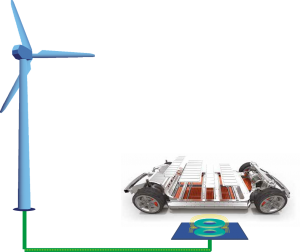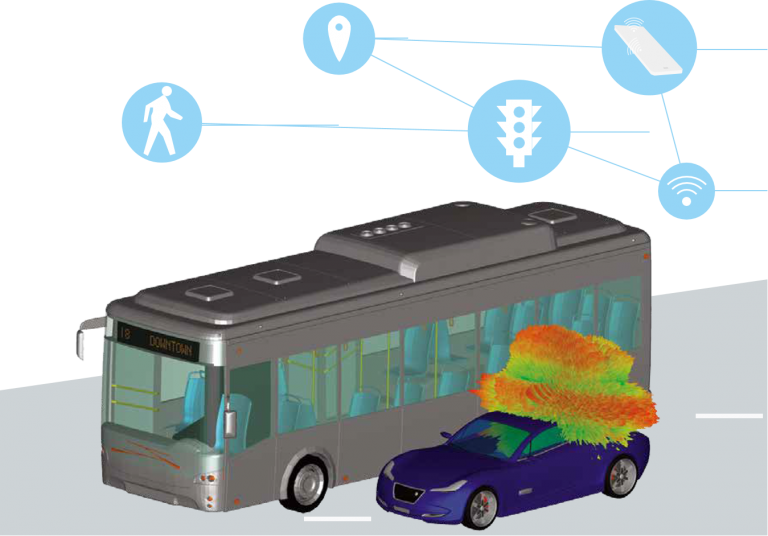This article was originally published in the September 2019 issue of REVEAL Magazine.
Despite a promising start, many autonomous car projects have run into roadblocks, and the dream of self-driving vehicles as a major part of the transportation mix still seems to be a long way off. Infrastructure has played a big part in this—autonomous vehicles (AV) are still driving on roads designed for humans, limiting their true potential. When autonomous driving goes mainstream, our entire infrastructure will change.
These changes will include smart roads, which will give AVs a more accurate picture of traffic around them, increasing safety while reducing congestion. Advanced 5G communication links between vehicles and surrounding infrastructure will allow AVs to react in real-time to other traffic users and then coordinate their driving. Meanwhile, a smart charging network would not only prevent AV batteries from ever running out but could potentially be used to help balance the power grid and reduce the carbon emissions of electricity production.
For AVs to be successfully integrated into the mainstream of automotive traffic, road infrastructure needs to operate safely and reliably in all weather conditions, with congested roads and all kinds of potential interference sources. Simulation is essential for modeling these challenging real-world conditions and driving the design of complex systems associated with this space.
STAYING CONNECTED IN A SEA OF CARS

Communication between road users today is almost non-existent. Taxis, trucks and emergency services have radios that allow two-way voice conversations, but most drivers rely on nothing but lights and hand gestures.
Similarly, most information communicated to drivers comes from road markings and signs. To mimic the reading of this information, current autonomous vehicles are fitted with cameras and image recognition systems that are able to read signs the same way a human would, which can also present a set of challenges when it comes to ensuring their proper detection and recognition.
To tackle both these challenges, radio frequencies around 5.9 GHz are being set aside for “vehicle-to-vehicle” (V2V) and “vehicle-to-everything” (V2X) networks, with some highways in the EU already equipped with prototype V2X systems. The fifth generation of mobile data standards (5G) is another possibility for V2X communication, giving the advantage of allowing V2X systems to use the same infrastructure as other mobile systems. This will allow vehicles to augment their capabilities compared to relying purely on vision and existing signs.
No matter which frequency is used, these systems need to be reliable. Coverage over the entire roadway to eliminate blind spots in the vehicle’s antennas is critical considering that there can be hundreds of vehicles on a single stretch of highway. Autonomous vehicles need to communicate with the highway infrastructure even as it drives past a truck that blocks its antennas.
To ensure connectivity, electromagnetic simulation is used to optimize antenna performance in real-world conditions. This can be a computationally challenging simulation. At 5.9 GHz, the free space wavelength is just 5 cm, while a bus or truck can be tens of meters long, meaning that the simulation needs to calculate a very large numerical problem. Powerful solvers, hybrid simulation approaches and cloud-based high-performance computing are needed to meet these challenges.
THE SMART ROAD
From black ice to broken down vehicles, there are numerous hazards that can occur at any time on the road. “Smart road” is the catch-all term for the range of technologies that can be used to monitor road conditions and transmit them to vehicles. For AVs, this informs the car about which route to take, how to drive, and can even help it save fuel by joining a platoon of vehicles coordinated by the smart road. The slipstream of a large truck can reduce the air resistance on the vehicles behind it, but autonomous driving is necessary to get close enough to the lead vehicle safely. Aerodynamic simulation helps calculate the optimal driving pattern to maximize this slipstreaming effect.
One use of smart-road technology already becoming mainstream is the monitoring and controlling of traffic congestion. A combination of different sensors, including cameras on gantries and magnetic sensors buried in the road surface, counts the number of vehicles on the road and their flow. Based on this data, temporary speed limits can be imposed and extra lanes can be opened. Delay information can be passed on to mapping and navigation software to suggest alternative routes. AVs will make driving on smart highways more sophisticated, adjusting car behavior in real-time to optimize traffic flow at all times.
The sensors will, however, be susceptible to interference from the environment and other sensors and broadcast systems—the more transmitters there are on the road, the more interference potential. Special interference-simulation techniques can quickly highlight potential interference risks and let engineers explore different mitigation techniques. Rain, snow, dust, and ice as well as soiling from passing vehicles will also reduce sensor performance. This can be modeled using fluid dynamics to simulate the soiling effect, followed by an electromagnetic simulation.
CLEAN POWER
The majority of AVs currently in development are electric. Today, drivers of electric vehicles charge their cars using cables, but how can AVs charge without the help of humans? One suggestion has been to include robot arms that can plug themselves in, while another is to use wireless charging. Imagine coils buried in the road or parking spots to transmit energy to a receiver coil mounted on the bottom of the car—the same principles used to charge phones wirelessly but on a much larger scale. Simulation of the coil shielding is a key step in the process to make sure stray power fields do not cause interference on the road and to ensure the safety of the passengers inside or pets finding shelter underneath a vehicle when parked.
Wireless charging is especially efficient for buses and delivery vehicles, which stop frequently and park in predictable places. Other vehicles that might benefit from a charging network are autonomous taxis and parcel-dispatch systems. This also promises to help personal car users; instead of needing to find parking at their destination, passengers disembark and let the car drive itself empty to a central parking bay installed with charging coils, and then return when summoned.

Most vehicles today spend the vast majority of the day empty and stationary. Car-share programs and autonomous taxis reduce this wasteful parking time, increasing the utility of each AV. But there will always be times—nighttime, midday, weekends—when demand for vehicles is lower. The power grid can already monitor such variations in both supply and demand, especially with sources such as wind and solar that are very sensitive to weather conditions.
Vehicle-to-grid (V2G) is an innovative concept that solves both problems at once, allowing a parked AV’s onboard battery to be used to store electricity when there is a surplus and then to return it to the grid when demand outstrips supply. Researchers have suggested that this means an autonomous vehicle fleet is not just a transportation asset but also a power-delivery asset. Adding V2G technology into AVs can significantly increase the profitability and practicality of autonomous taxi technology.
Existing grid-control scenarios will need to be adapted, smart meters will have to be rolled out, and infrastructure such as cables and transformers will need to be upgraded to get power to where it is needed.
The design of high-voltage power-grid components such as transformers requires electromagnetic, thermal and structural effects to be considered simultaneously. Each domain of physics is tightly linked to the others—for instance, electric currents can overheat the device, while vibrations can cause mechanical damage— and tightly integrated, multi-domain analysis is needed to model these phenomena properly.
SUMMARY
Autonomous vehicles will only live up to their promise if the infrastructure is in place to support them. This means a major upgrade of our roads, cities and power grids. Smart infrastructure can not only direct traffic more efficiently but also increase safety, while wireless charging and vehicle-to-grid technology will help the radical decarbonization needed to meet emissions targets. Simulation will play an important role in designing the components of these systems and ensuring that they operate without interference in real-world conditions.
